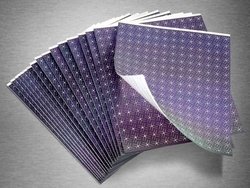Nanosolar is a solar company that knows all about high expectations.
Since being founded in 2002 in San Jose, California, the company has been seen as a “solar savior” that would bring panel costs under a dollar per watt.
You may recall that there have been other solar companies that were touted as having a revolutionary technology that would be a “game changer” in the solar industry. Many of these companies disappeared from the map before producing a single solar panel.
Would the same fate befall our faithful hero Nanosolar?
Thankfully, no.
That does not mean, however, that the company has changed the solar industry just yet. It appears that the jury is still out on what kind of impact these “printed on” solar cells will have on the market, but at this point it’s safe to say that the technology is more than just “smoke and mirrors”.
Let’s get into a little company background to try to figure out if you should be considering “nano-panels” for your solar installation.
The company was founded by Martin Roscheisen and Brian Sager. Roscheisen is a technology entrepreneur who had built and sold a bunch of companies before getting involved with renewable energy in 2002.
He acted as Nanosolar’s CEO until March of 2010 when he was replaced without any public explanation (trouble in the boardroom, perhaps?).
Sager has a background in biochemistry and he is currently VP of Corporate Development. Here he is in a YouTube video talking about the company’s unique solar cell technology:
Solar panel technology is what sets Nanosolar apart from the many other solar manufacturers in the game. While most solar panel companies produce their panels with crystalline silicon (which is pretty expensive), our friends at Nano use a thin film solar panel technology known as CIGS (which stands for copper indium gallium selenide).

Using CIGS is not unique, other companies like MiaSole, Global Solar, and Solyndra also use the technology in their solar products. What is unique to “nano-panels” is the “roll to roll printing process” that allows solar cells to roll off the press like newspapers.
The “paper” that the solar cells are printed on, however, is actually a flexible aluminum-alloy substrate.
The process of using semiconductor ink on an aluminum substrate will theoretically allow Nanosolar to use cheaper materials (and less of them) to create a less expensive solar module and give them higher “throughput” (this refers to how many panels can be produced in a given time).
So how is that working out for them?
Well, it seems that despite raising half a billion dollars the company has been having some trouble in actually getting their solar panels produced and installed out in the sunshine.
There were signs of life in 2010, however, when the company announced the completion of a 1.1 megawatt solar power plant in Luckenwalde, Germany.
According to a company press release, the solar plant was “connected to the EEG in June 2010” and is using “thousands of Nanosolar Utility Panels” to produce honest-to-goodness solar power from the light of the sun.
Now, here’s the problem: Getting any sort of independent verification about this installation has been exceedingly difficult. In fact, outside of the company’s own press release, the available information seems to cast doubt on whether this solar farm is fully operational.
So as to whether you should be considering these modules for your solar installation, the answer is “no”. Even if you wanted to buy the panels they are not yet commercially available.
Does this mean that you should write off the company as a potential player in the thin film solar business? The answer to this one also seems to be “no”.
The company has made some management changes and appears to be ready to make the transition from “talking the talk” to “walking the walk”.
They just aren’t quite there yet.
